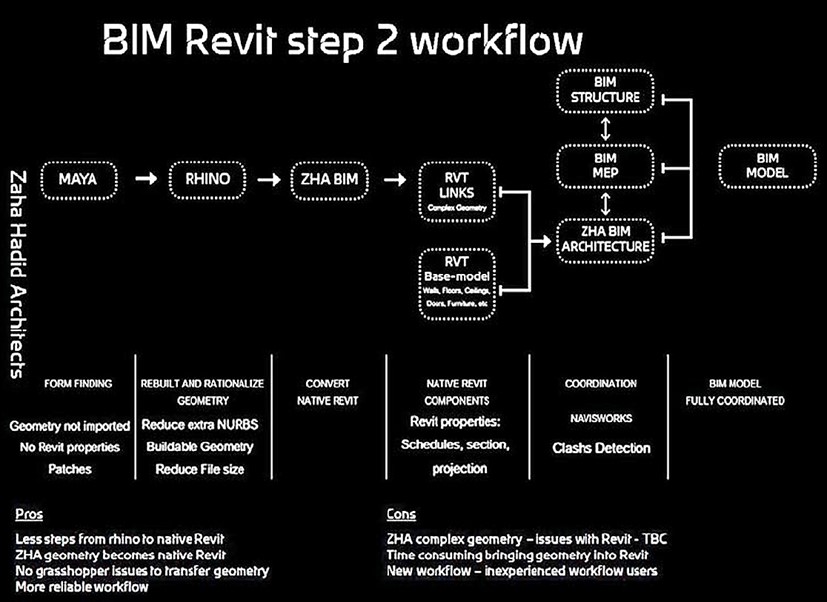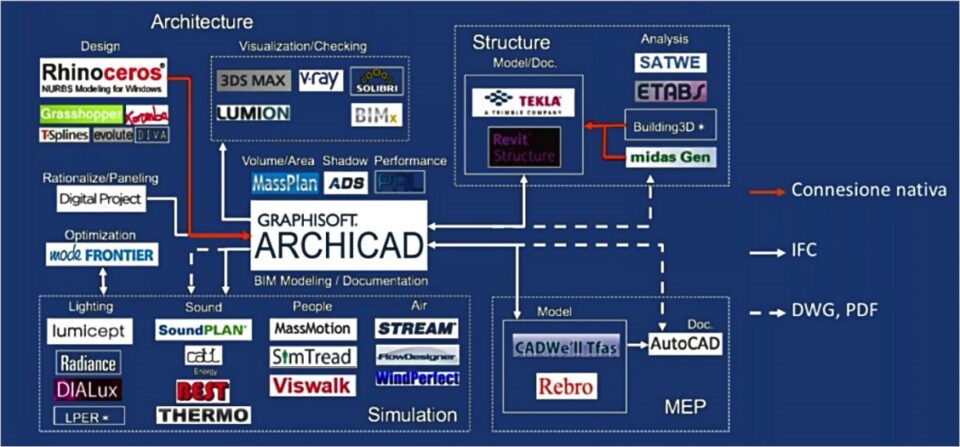The 🇮🇹 version is at the bottom of this page here
I start from the image below that pops up from a LinkedIn post (credit is in the image):
“Revit is just another tool in our BIM toolbox”
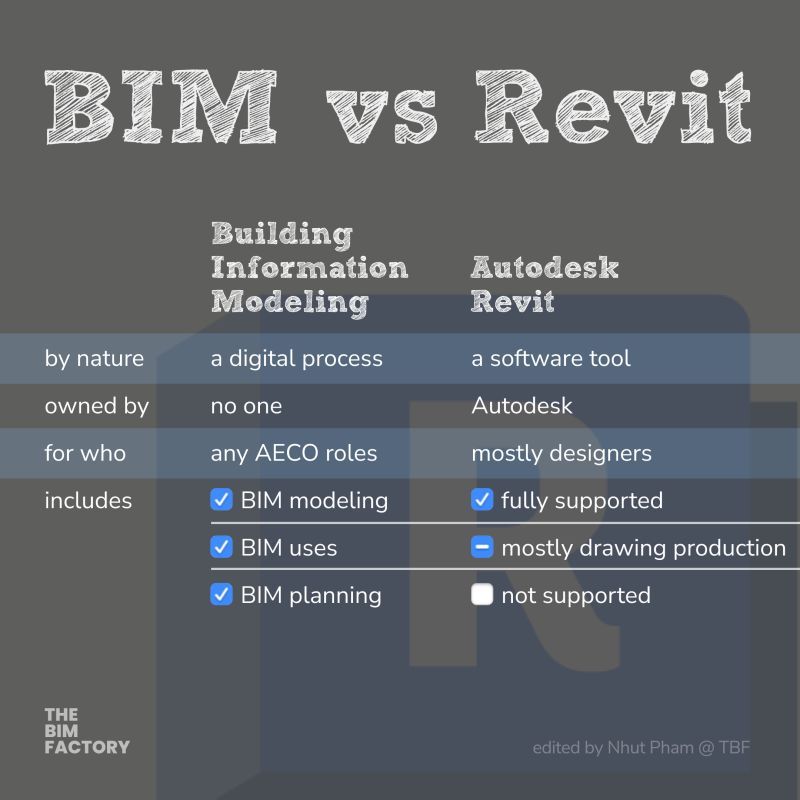
It is always very useful to underline this substantial distinction between a process and software, I agree.
Another aspect that, in my opinion, is closely linked to BIM as a process is that of interoperability because in the same way it must always be remembered that:
Operating with proprietary formats is extremely advantageous for a loyal user (totally devoted to a single software house) and it undoubtedly has a certain productive advantage, but we cannot speak of interoperability if we are not able to put two software of different origins and with different production objectives in communication if we do not fully embrace the Open philosophy (and therefore of neutral formats). There is no more neutral format than “data” because it is its structuring into “information” that makes it something useful and therefore valid in terms of design.
Just to be clear this is my opinion.
If I think about the meaning of interoperability it immediately comes back to me when I first used the cross-platform application Flux.io (a Google X program project) … it was amazing how the concept of interoperability and unchaining from the “slavery” of formats how really came to life in that way.
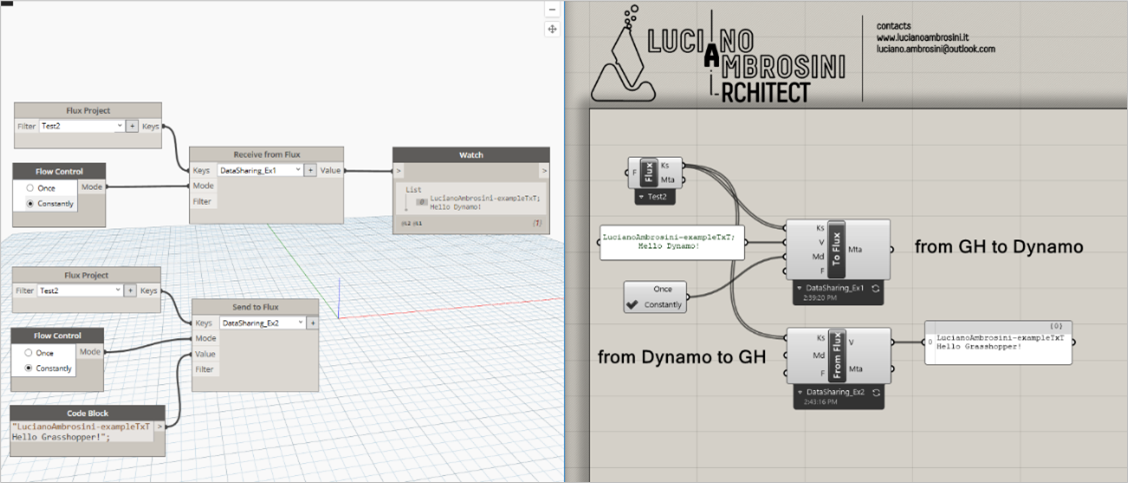
On the occasion of the webinar – share data no more models – (on GoToWebinar platform) held in May 2017 by Anthony BUCKLEY-THORP, managing partner of Flux.io (cloud data sharing, data storage and data design platform), the possibility to learn some aspects of the envelope design workflow followed by the BUROHAPPOLD Engineering articulated around data sharing and interoperability between the design platforms used in the design phase of the ARTIC – Anaheim Regional Transportation Intermodal Center by Hellmuth-Obata-Kassabaum (HOK) gridshell.
Flux.io was one of the innovative platforms that emphasized once again, a certain preferential relationship that the AEC industry has with the Software Houses that deal with technology at different levels, this is a determining factor for the innovative aspects that characterize the workflow of the big Firms and especially for large incoming projects. As evidence of what he learned, Anthony BUCKLEY, member of the FAST sector (Flux Advanced Service + Technology) of Flux.io, a spin-off of Google’s X program, explains that his training began at ARUP as a structural engineer having the good fortune to be able to develop multiple applications related to digital design and process automation.
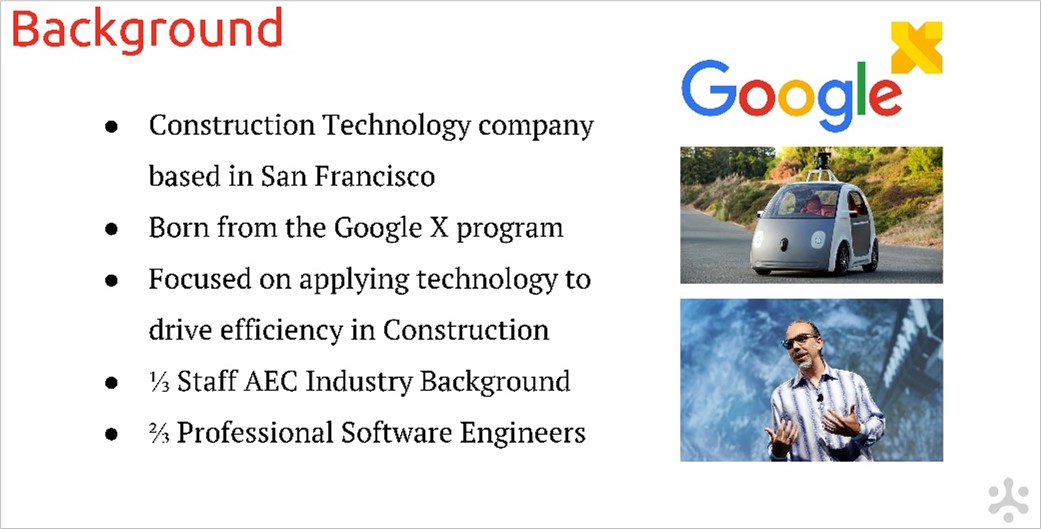
Currently the state of the art is recognised among the projects similar to the aforementioned experience, Speckle (with a great DEV Team), which in my opinion is among the major candidates to collect the cultural heritage left by Flux.io1The Google X Team on March 31, 2018 officially terminated the provision of the data sharing and data storing service offered by the Flux.io platform. This is because, as interoperability between platforms is a central theme in the philosophy of building information modelling, software projects related to data sharing/archiving/design represent a real “Eldorado” because they are able to ensure total strategic coverage among the most widespread application modules commonly used by design firms.

In operational terms, this digital integration could be interpreted as an improvement, for example, in preserving the copyright (think of the sharing of the source codes of the algorithms to rigorously define the geometric configurations of any work) and likewise the immediacy of sharing, between different teamwork, the input and output data necessary to implement the efficiency of the project pipeline. Hence the company’s motto was “share data no more models”.
BUROHAPPOLD, this is just one of the many virtuous testimonies, has benefited from the advantages offered by the cloud platform just mentioned by integrating multiple digital tools in order to improve and optimize its workflow shows the diagram that the engineering company has adopted for the realization of the geometry of the ARTIC gridshell. In the image below, I have graphically re-elaborated it, it is really clear how BIM is the medium and interoperability is the message – in the sense of profound meaning that all informative design processes encompass to produce the geometric-annotative artefacts.
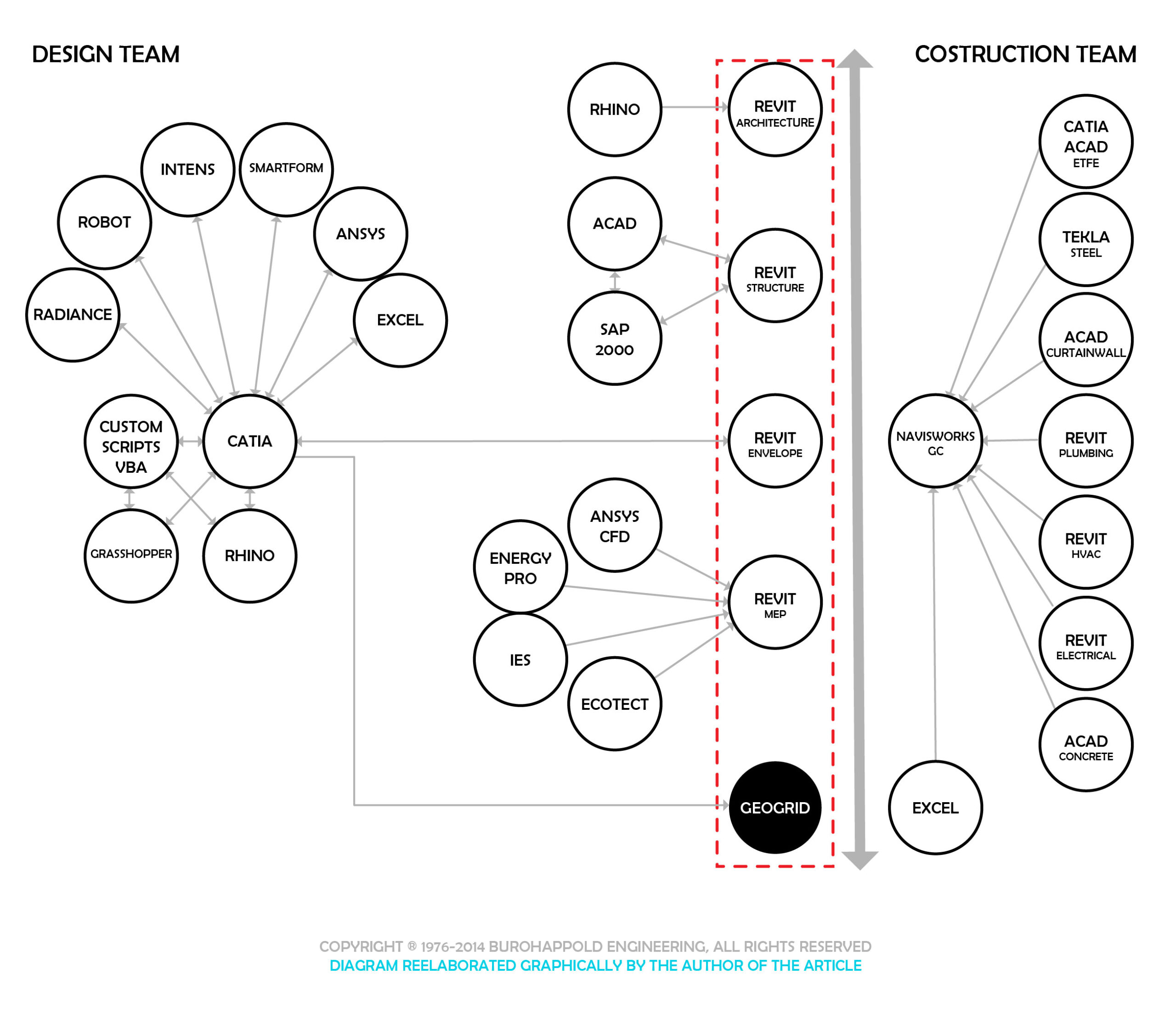
Other important Firms have adopted and are still adopting a systemic and holistic approach to design and these diagrams below illustrate the different phases of the production and design process bear witness to this.
The ZHA diagram workflow above, used in the design of the Hadid Tower and the Podium in the CityLife district of Milan (the shopping district), is a further testimony of the systemic approach.
The architect Paolo ZILLI2Zilli, ZHA Project Associate, has collaborated on numerous international projects of ZHA and among these also at the High Speed Station in Afragola (Naples) between 2008 and 2010 supervised the aspect of design interoperability between the various involved partners and, in particular, to ensure the operational transition from the level 1 BIM model to the more specifically executive level 2 (2014) in order to maximize the performance of the entire teamwork compared to the traditional tools and workflows adopted until then. . ZILLI always specifies that the first parametric models of the project (concept elaborated in 2004), were initially developed by integrating the use of Autocad with that of Excel spreadsheets, later it began, with the progress of the technologies integrated into the modelling software, the adoption of the Paracloud and Rhino, approaching then to the VPL Grasshopper platform and the scripting procedures in Visual Basic in the same development environment as Rhino.
As evidence of the spread of a professional practice based on the workflows just described, the methodology that the international design and engineering firm NIKKEN SEKKEI uses in the field of integrated design and construction based on the interoperable BIM model is shown as a demonstration of the interoperability concept. The second diagram image above shows, again, the diversified and intense use of IT tools and platforms capable of managing the constructive and design complexity of the integrated services offered by NIKKEN. The firm’s workflow has been tested since 2014 using the Archicad BIM platform (from version 17) for the management of construction aspects and integrated design. The Japanese firm has signed an advantageous partnership with the Software House GRAPHISOFT, as told by Mr Tomohiko YAMANASHI, executive officer and principal of NIKKEN SEKKEI in Tokyo, also underlining that half of the employees at the studios scattered around the globe (around 2400 professionals) are mostly architects.
The constant and growing presence of architects and personnel of the AEC industry within the Software Houses or in support of Software Developers is now a thriving practice to be pursued especially in view of the immediate mutations of professional roles in the architectural, design and obviously engineering fields.
The diagrams above have shown, especially in specific technical sectors, the huge presence of the IT platforms to define a consolidated practice recognized by many international professional realities. In each of them emerges (ZHA, HOK, BUROHAPPOLD, Nikken Sekkei etc.) a constant propensity for process customization using programmable digital tools and the data sharing platforms, for example, for the NIKKEN SEKKEI the Midas Gen platform represents a shining example.
However, the shadow of the disruptive power of interoperability can be a serious problem in terms of the growing demand for highly specialized professional profiles – profiles that are the result of practical rather than academic speculation. The work of the architect and the designer is probably the profession most exposed to radical changes in the immediate future subject to the constant and progressive evolutions that occur in each of the technological levels described by Kevin KELLY3Kelly, K. (2017). The inevitable: understanding the 12 technological forces that will shape our future (3rd printed.). New York: Penguin Books., changes perceived both on the instrumental and on the cultural side of the production of the digital project. The meaning of this last assertion is found in MOSER4Moser, C. (2017). BIM Disruption 2016: The Disruption of Interoperability. Independently published (January 1, 2017)5F. Aimar, 2017, I professionisti del BIM, eBook, Wolters Kluwer, the researcher tries to describe a new figure of architects to whom they are increasingly associated and assigned different and innovative tasks.
“A new role that interfaces with solutions that are often unique, customized and designed to define a symbiotic relationship between the idea and the prototype”
MOSER reports in his book BIM disruption 2016: the disruption of interoperability, that the central role of the architect and designer is mainly linked to destiny and the continuous birth of new forms of work for which we need and will need new spaces, new geometries, new interactions. architectural and, for these reasons, the designer of the Digital Era must necessarily be oriented towards the problem-solving of specific critical issues in total becoming as the future job market is defined.
Once again the aspects of information modelling, since it is aimed at people, recognize strong and essential human connotations in interoperability, potentially unrelated to the logic imposed by the Software House or at least it should be.
Finally, I have the personal belief that the power of interoperability is mainly contained in its “soft” aspect even before “hard”, I refer to the community aspect (and not so much to the hardware/software aspects that are functional). More often some significant “technological upgrades” come right from the bottom, from virtual communities, from the “Discourse forums” for example (it is well known that many beta-testers of the AEC industry are enlisted in these places). These are places where human interoperability is palpable from which collective technical knowledge takes shape not as a sum of the individual one but as collective intelligence, but this will probably be discussed in my next article.
For researchers or Digital Architecture lovers
If this article has inspired or just driven you curious and you want to cite this, please read below:
the contents are part of these paragraphs from my PhD thesis:
- 2.2 Zaha Hadid Architects (ZHA) Generali Tower – CityLife
- 2.3 Hellmuth-Obata-Kassabaum (HOK) e il progetto ARTIC – Anaheim Regional Transportation Intermodal Center (the BuroHappold experience)
🇮🇹 version
Inizio da questa immagine pubblicata su LinkedIn (i copyright sono riportati nell’immagine):
“Revit è solo un altro strumento nella nostra cassetta degli strumenti BIM”

É sempre molto utile sottolineare questa sostanziale distinzione tra BIM come processo e la sua identificazione con un software di BIM authoring, concordo.
Un altro aspetto che, a mio parere, è strettamente legato al concetto di BIM come processo, è quello della interoperabilità, perchè allo stesso modo va ricordato, sempre, che:
Operare con formati proprietari è estremamente vantaggioso per un utente fidelizzato (totalmente devoto ad un unica software house) e indubbiamente ha un certo vantaggio produttivo. Tuttavia, non si può parlare di interoperabilità se non si è in grado di mettere in comunicazione due software di diversa provenienza e con diversi obiettivi produttivi se non si abbraccia completamente la filosofia Open (e dunque del formato neutro). Non esiste formato più neutro di un “dato”, perché è la sua strutturazione in “informazione” che lo rende qualcosa di utile e dunque valido in termini progettuali.
Per intendersi questa è una mia opinione.
Se penso al significato del termine interoperabilità, mi torna in mente immediatamente quando utilizzai per la prima volta l’ applicativo cross-platform Flux.io (un progetto del Google X program)…era incredibile come realmente il concetto di interoperabilità e di liberazione dalla “schiavitù” dei formati proprietari potesse prendere vita in quel modo.

In occasione del webinar – share data no more models – (su piattaforma GoToWebinar) tenutosi a maggio 2017 da Anthony BUCKLEY-THORP, managing partner di Flux.io (piattaforma cloud di data sharing, data storage e data design), si è avuta la possibilità di apprendere alcuni aspetti del flusso di lavoro seguito dal Team di BUROHAPPOLD articolato attorno al data sharing e all’interoperabilità tra le piattaforme di progettazione adoperate in fase di design della gridshell di ARTIC – Anaheim Regional Transportation Intermodal Center by Hellmuth-Obata-Kassabaum (HOK) gridshell.
A tal riguardo risulta utile fare un breve inciso tecnico di seguito proposto.
Innanzitutto, si sottolinea ancora una volta, un certo rapporto preferenziale che l’AEC industry ha con le Software House che si occupano di tecnologia a diversi livelli, questo è un fattore determinante per gli aspetti innovativi che caratterizzano il flusso di lavoro delle grandi firme e in particolar modo per le grandi commesse. Inoltre, a testimonianza di quanto appreso, Anthony BUCKLEY, membro del comparto FAST (Flux Advanced Service + Technology) di Flux.io, uno spin-off del programma X di Google, spiega che la sua formazione è iniziata presso ARUP come ingegnere strutturista avendo, dunque, la fortuna di poter sviluppare molteplici applicativi relativi al digital design e all’automazione dei processi – nodo fondamentale.

Attualmente lo stato dell’arte sta riconoscendo tra i progetti simili all’esperienza su citata, Speckle (con un grande team di sviluppatori), che personalmente ritengo essere tra i maggiori candidati a raccogliere il patrimonio culturale lasciato da Flux.io [1]. Questo perché, Essendo l’interoperabilità tra piattaforme un tema centrale nella filosofia del building information modelling, i progetti software inerenti alla condivisione/archiviazione/design dei dati rappresentano una vera “Eldorado” perchè in grado di assicurare una copertura strategica totale tra i più diffusi moduli applicativi comunemente impiegati dagli studi di progettazione.

In termini operativi, tale integrazione digitale potrebbe essere interpretata come una miglioria, ad esempio, della tutela del diritto d’autore (si pensi alla condivisione dei codici sorgente degli algoritmi per definire rigorosamente le configurazioni geometriche di qualsiasi opera) e, parimenti, l’instantaneità della condivisione, tra diversi collaboratori, dei dati di input e output necessari per implementare l’efficienza della pipeline di progetto. Da qui il motto dell’azienda “condividere i dati non più modelli”.
BUROHAPPOLD, ma questa è solo uno delle molteplici testimonianze virtuose, ha beneficiato dei vantaggi offerti dalla piattaforma cloud appena citata integrando molteplici strumenti digitali al fine di migliorare e ottimizzare il proprio flusso di lavoro come mostrato nel diagramma del flusso di lavoro adottato per la realizzazione dell’involucro dell’ARTIC grisdhell. Nelle immagine che segue, nella quale ho graficamente ri-elaborato il diagramma, è eloquente il significato del titolo di questo articolo – il BIM è il medium e l’interoperabilità il messaggio – nel senso di significato profondo che tutti i processi progettuali informativi racchiudono nell’atto di produzione degli artefatti geometrico-annotativi.

Altri importanti studi di progettazione hanno adottato e continuano ad adottare un approccio sistemico e olistico alla progettazione e questi schemi che illustrano le diverse fasi del processo produttivo e progettuale ne sono una testimonianza.
Il diagramma del flusso di lavoro adottato da ZHA per la progettazione della Torre Hadid e del Podium nella City Life di Milano (district shopping) è una ulteriore testimonianza dell’approccio sistemico. L’architetto Paolo ZILLI [2] tra il 2008 ed il 2010 si è occupato di supervisionare l’aspetto dell’interoperabilità progettuale tra i diversi partners coinvolti e, in modo particolare, di accertarsi della transizione operativa dal modello BIM di livello 1 a quello più specificamente esecutivo di livello 2 (2014) al fine di massimizzare le performance dell’intero teamwork rispetto ai tradizionali strumenti e flussi di lavoro sino ad allora adottati. Precisa sempre ZILLI che i primi modelli parametrici dell’opera (concept elaborato nel 2004), sono stati sviluppati inizialmente integrando all’ uso di Autocad quello dei fogli di calcolo Excel, in un secondo momento ha avuto inizio, col progredire delle tecnologie integrate nei modellatori software, l’adozione di Paracloud e Rhino, approcciando poi alla piattaforma VPL Grasshopper e alle procedure di scripting in Visual Basic nello stesso ambiente di sviluppo quale Rhino.
A testimonianza della diffusione di una pratica professionale fondata su flussi di lavoro appena descritti si riporta, a titolo dimostrativo, la metodologia che lo studio internazionale di progettazione ed ingegnerizzazione NIKKEN SEKKEI adopera nell’ambito della progettazione e costruzione integrata basata sul modello interoperativo BIM. Il secondo diagramma su riportato mostra, ancora, l’uso diversificato e intenso di strumentazioni e piattaforme informatiche in grado di gestire la complessità costruttiva e progettuale dei servizi integrati offerti dalla NIKKEN. Il flusso di lavoro dello Studio è sperimentato già dal 2014 mediante la piattaforma BIM Archicad (dalla versione 17) per la gestione degli aspetti costruttivi e quelli della progettazione integrata. Lo studio giapponese ha sottoscritto una vantaggiosa partnership con la Software House GRAPHISOFT, come racconta Mr. Tomohiko YAMANASHI, executive officer e principale della NIKKEN SEKKEI di Tokyo, sottolineando, inoltre, che la metà degli impiegati presso gli studi sparsi per il globo (circa 2400 professionisti) sono perlopiù architetti.
La costante e crescente presenza di Architetti e personale dell’AEC industry all’interno delle Software House o a supporto degli Sviluppatori di Software è ora una florida pratica da perseguire soprattutto in vista delle immediate mutazioni delle figure professionali in ambito architettonico, del design e ovviamente dell’ingegneria.
I diagrammi dei flussi di lavoro qui proposti mostrano specialmente nelle aree tecniche un enorme uso/presenza delle piattaforme IT che definisce una consolidata pratica progettuale riconosciuta oramai da molteplici realtà professionali. In ognuno di essi (ZHA, HOK, BUROHAPPOLD, Nikken Sekkei etc.) emerge una costante propensione alla customizzazione del processo attraverso l’uso di strumenti digitali programmabili e di piattaforme di condivisione dati, ad esempio, per la NIKKEN SEKKEI la piattaforma Midas Gen ne rappresenta un fulgido esempio.
Ad ogni modo, l’ombra del potere disruptivo della interoperabilità può rappresentare un serio problema in termini di richiesta crescente di profili professionali altamente specializzati – profili che sono il risultato di speculazioni pratiche più che accademiche. Il lavoro dell’architetto e del designer sono probabilmente le professioni più esposte ai radicali cambiamenti professionali nell’immediato futuro poiché assoggettati alle costanti e progressive evoluzioni che si registrano in ciascuno dei layers tecnologici descritti da Kevin KELLY [3], cambiamenti percepiti tanto sul versante strumentale quanto su quello culturale della produzione del progetto digitale. Si ritrova il senso di quest’ultima asserzione in MOSER [4], il ricercatore cerca di descrivere una nuova figura di architetto a cui sempre più spesso si associano e assegnano mansioni differenti e innovative.
“Una nuova figura che si interfaccia con soluzioni spesso uniche, personalizzate e atte a definire un rapporto simbiotico tra l’idea e il prototipo”
Riporta MOSER nel suo libro BIM disruption 2016: the disruption of interoperability, che il ruolo centrale dell’architetto e designer è legato maggiormente al destino e alla nascita continua di nuove forme di lavoro per le quali bisogna e bisognerà prevedere nuovi spazi, nuove geometrie nuove interazioni architettoniche e, per tali motivi, il progettista dell’Era Digitale dovrà essere necessariamente orientato al problem-solving di specifiche criticità in totale divenire a mano a mano che si andrà a definire il futuro mercato del lavoro.
Ancora un volta gli aspetti della modellazione informativa, poiché rivolta alle persone, riconosce nella interoperabilità forti ed essenziali connotazioni umane slegate, in potenza, dalle logiche imposte dalle Software House o almeno così dovrebbe essere.
Concludendo, personalmente credo che il potere dell’interoperabilità sia principalmente contenuto negli aspetti “soft” più che in quelli “hard”, mi riferisco specialmente agli aspetti “comunitari” (di community, e non tanto agli aspetti hardware/software che sono funzionali). Molto spesso alcuni degli “upgrades tecnologici” nascono proprio dal basso (approccio bottom-up), dalle comunità virtuali, ad esempio dai diversi forum targati “Discourse” (è infatti cosa nota che molti beta tester sono assoldati proprio in questi luoghi di ritrovo virtuali). In questi luoghi l’interoperabilità umana è palpabile e da essa prende forma la conoscenza tecnica non come somma di quelle individuali ma, piuttosto come forma di intelligenza collettiva, ma questo sarà probabilmente un tema da trattare nel mio prossimo articolo.
Per Ricercatori o appasionati di Architettura Digitale
Se questo articolo ti ha ispirato o semplicemente incuriosito e vorresti citarlo, per favore dai un’occhiata qui sotto:
Parte degli argomenti trattati sono contenuti nei seguenti paragrafi della mia tesi di dottorato:
- 2.2 Zaha Hadid Architects (ZHA) Generali Tower – CityLife
- 2.3 Hellmuth-Obata-Kassabaum (HOK) e il progetto ARTIC – Anaheim Regional Transportation Intermodal Center (the BuroHappold experience)

